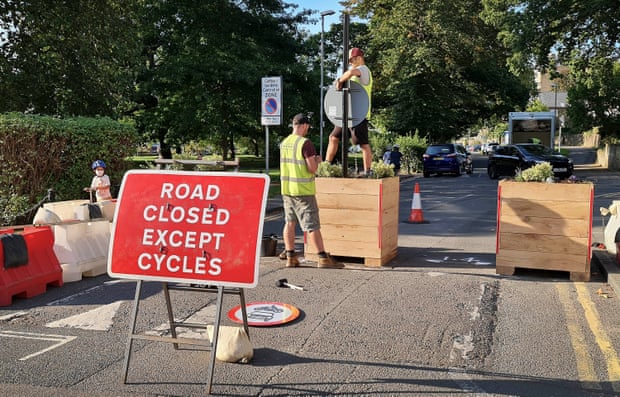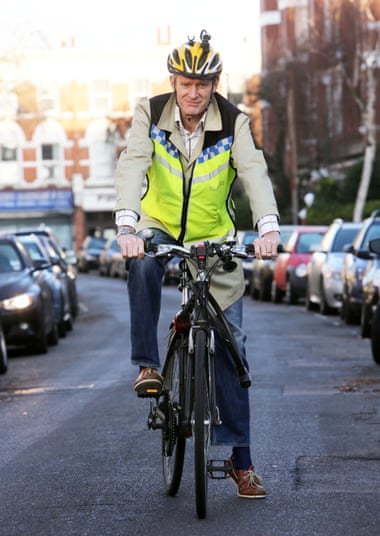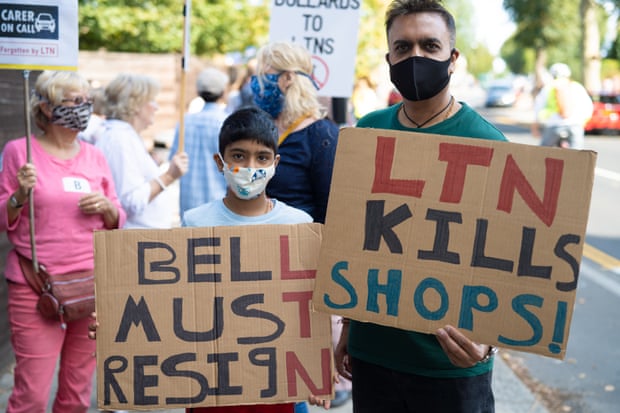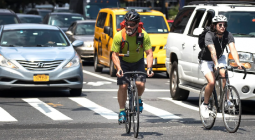Car-free neighbourhoods: the unlikely new frontline in the culture wars.

Covid measures to encourage cycling and walking in UK cities should have been a victory for the environment and wellbeing. So why are communities so divided?
On a rainy Tuesday evening, a couple of weeks ago, Tom – not his real name, for reasons that will become clear – took his 12-year-old son to football practice. Training is two miles away, and usually they would travel by car. But, over the summer, the area where they live in Ealing, west London, was designated a low-traffic neighbourhood (LTN). This meant that its streets would be altered to encourage “active transport” such as cycling and walking, typically by placing planters and bollards across key intersections. The introduction of the LTN scheme in Ealing had created confusion among motorists and congestion on the main roads. It also led Tom to dig out his bicycle, which he bought when he moved to London in 2003 but which had been gathering dust for 15 years.
The journey to football was unremarkable, wobbling through unfamiliar streets, scrabbling to make it on time. Cycling back, though, the rain falling harder now, a strange feeling came over Tom. “There were no cars around,” he recalls. “It was dark. It was wet. But it was magical. It was just seeing the place where I live in a totally different light. Everybody’s quite angry at this moment in time, and I just felt – for the first time in a long while – that lift and that mood change.” When he and his son got home, they decided they would go on their bikes again the following week. “I hope maybe when he gets older, if we keep it up, he’ll remember cycling to football with his dad,” Tom says. “Rather than sitting in the back seat of the car.”
It’s a sweet story. “Just something normal,” says Tom, “or something that should be normal.” It’s also exactly the kind of experience that low-traffic neighbourhoods were designed to encourage. There have been similar, albeit more limited, initiatives in the past in the UK, but the LTN proposal only dates back to May this year, when Boris Johnson announced during prime minister’s questions that we would soon be entering “a new golden age for cycling”. He put his money where his mouth was: soon after, the Department for Transport released £250m of “emergency active travel funding” to English local authorities. Encouraging walking and cycling was now regarded as “essential” to “avoid overcrowding on public transport systems as we begin to open up parts of our economy”.

LTN schemes would be trialled in cities including Sheffield, Manchester and Birmingham, but their introduction was deemed particularly essential to London. In May, Transport for London (TfL) needed a government bailout of £1.6bn and was required to institute LTNs as a condition of the recovery package. The fear was that Londoners, wary of using buses and the underground, would take to their cars, causing unprecedented congestion and pollution. TfL outlined a strategy to increase the number of journeys made on foot by a multiple of five, and the journeys made on bike by 10. By the end of the summer, at least 160 new schemes had been introduced across the majority of the capital’s 32 boroughs. It was perhaps the most dramatic reshaping of these streets since the second world war.
The scheme generated by Johnson’s Conservative government was rolled out with great enthusiasm by Labour’s mayor of London, Sadiq Khan. At last, something was being done to address the problem of traffic on London’s residential streets, which had increased by 72.2% between 2009 and 2019, and of air quality that had become “filthy, toxic” and “a public health crisis”, according to Khan. Increasing the use of active transport would make citizens fitter, improve their mental health and give them greater resilience to Covid-19. Low-traffic neighbourhoods were a win, win, win – one of the few potential positives to come out of the pandemic.
Just a few months after the first low-traffic neighbourhoods were introduced, it’s safe to say that few people think they are a miracle policy any more. In Ealing, which was given more than £600,000 by TfL for active-transport initiatives, opposition has been especially fierce. Planters marking the new road layouts have been defaced and overturned, the bollards have been stolen and the holes left in the road filled in with cement. A march to protest against the LTNs in September had a turnout estimated at 2,500, while more than 10,000 people have signed a petition objecting to the scheme.
Low-traffic neighbourhoods have been similarly contentious in other parts of London. John Locker, a Conservative councillor in Wandsworth, said: “It is clear that the LTNs are not delivering the benefits we want to see. In fact it looks like the combination of changes… are unfortunately having the opposite effect.” The borough scrapped its scheme in September.
Lewisham plans to make significant changes to its LTNs this month. In Hackney, Labour councillor Jon Burke received a death threat over the new measures. “We intend to burn down your house while you are sleeping,” a scrawled note read. “Stop this traffic – open all road now or we will get violence [sic].”
Start looking into low-traffic neighbourhoods and the vitriol, suspicion and chicanery is disturbing. It is no surprise that “Tom” from Ealing asks to use an assumed name. “I know a lot of the parents that were marching against the LTNs, even the ones holding the banners,” he explains. “And you think, ‘OK, do I really want any hassle or blowback next time we turn up to football?’”

Some of the objections to low-traffic neighbourhoods come from predictable sources: motorists, for example, who now find a five-minute errand takes them 20 minutes or who have had a chunk of time added to their commute. Delivery drivers, an essential service in the Covid age, have been inconvenienced by the new measures, forced to adapt to new road layouts while still making their requisite number of drops per hour. But what has been unexpected is the diverse nature of campaigners within the anti-LTN groups. Even some of the individuals themselves are surprised. Rosamund Kissi-Debrah says: “If you randomly rang me up and said, ‘Rosamund, what do you think about a low-traffic neighbourhood?’, I’d say, ‘Ooh, that sounds great definitely.’ But where I live, and I can only talk about Lewisham, it has been a disaster.”
Kissi-Debrah is a World Health Organization clean-air advocate whose nine-year-old daughter Ella died in 2013 after suffering a series of severe asthma attacks. She lives in Hither Green, south-east London, just off the South Circular, one of London’s busiest roads. Ella loved to cycle, scoot and skateboard – “you name it” – and her two siblings are similarly “obsessed with two wheels”. Kissi-Debrah follows behind them on a scooter: “A manual one, not electric,” she exclaims. “So I can’t be anti-cyclist.”
For Kissi-Debrah, the issue with low-traffic neighbourhoods is air quality and fairness. “For people who live in an LTN, yes, life is better, I don’t deny that,” she says. “But their traffic is going somewhere. And this brings up all sorts of issues: social justice and environmental justice. You cannot live in a neighbourhood where one part has an LTN and children are cycling and playing outside and the roads are safe, then pop along a couple of roads later and there’s gridlocked traffic. We cannot live in a society like that.”
Kissi-Debrah’s intervention in the debate appeared to be influential in Lewisham’s ongoing rethink of its LTNs. And she has received considerable opprobrium on social media for her stance. She says: “This is the hardest time people have given me. But I can only speak my truth. No, some people are not happy with me at all.” Others have told her that she has secured a “victory” for the anti-LTN campaign, though Kissi-Debrah doesn’t like that angle either.
“It’s not victorious that I know a mother who had to rush her three-year-old to the local hospital to put them on a nebuliser,” she says. “I don’t want any other family to go through what we went through. That’s my aim all the time, but unless we change things right now I’m not going to get my wish, am I?”
Even the most impassioned advocates of LTNs have to concede there have been fundamental problems in some areas. Along with unprecedented investment back in May, local authorities were given the power to introduce the schemes as emergency traffic regulation orders, ostensibly because of the fast spread of Covid and the need to offer social distancing to residents. Typically, consultations on such matters might last months, even years, involving mail-outs, meetings and even local votes. The new LTNs would instead be given a six-month trial and then reviewed. In boroughs such as Ealing, where the council has a stated ambition to become “the cycling Copenhagen of London”, there were fears that these reviews would be akin to them marking their own homework.
“There’s a set of objections that it was done too fast,” says Dave Hill, editor and publisher of the website On London, which has tracked the LTN debate closely. “Some of them haven’t been very well designed. And some people are furious, because they feel this has been done to them without anybody asking. That’s a small example of a bigger thing, about people feeling that politicians don’t listen to them.
“Where does Covid come in?” Hill continues. “Well, you wonder whether Covid has to some extent given the government cover for forcing certain things through.”
Hill also thinks that the typical demographic of the London cyclist has become a factor. According to TfL’s Cycling Trends Update of July 2019, only 27% of cycle trips are made by women and more than 85% of the city’s cyclists are white. A high proportion – often more than 20% or 30% – are from households with a yearly income of over £75,000. Some of those opposed to LTNs clearly feel that the schemes encourage gentrification by stealth. “For some people in some of those areas,” says Hill, “the whole cycling, clean air, low-traffic neighbourhood agenda is another example of their neighbourhood changing in ways they don’t like and don’t have any control over.”
And yet, it also feels like something does have to change. There are, in 2020, 38.4m licensed vehicles in Great Britain; this number has grown every year bar one (1991) since the second world war. In 2019, according to the Department for Transport, 130m more miles were driven in Ealing alone than in 2012. TfL has found that more than a third of all car journeys made by London residents are under 2km (1.25 miles).

For a cyclist such as broadcaster Jeremy Vine, who rides at least 14 miles each day between his home and work in London, urban transport in Britain needs to be overhauled. “In a city as compact as London, you can’t justify people driving around in two-tonne metal boxes with an empty armchair beside them and an empty sofa behind them,” he says. “It’s just nuts. But once you start to say, ‘right, if you want to drive in a big metal box, that’s fine, but you can’t go down here, here and here’ people just go completely mad about it. To the point where somebody says, ‘your neighbourhood is going to be an LTN’ and everyone goes, ‘you’re fucking joking! I don’t want that.’”
Vine would start by reallocating road space and strongly enforcing penalties. “If you’ve bought a really fancy car to whiz around London, because you want to listen to Bruce Springsteen playing Born to Run, you need to find a different city,” he says. “Go and rent a car in America and you can do that. You can’t do that in our big cities in Britain.”
At a glance, Ealing does not appear to be a community in chaos. It is a place of comfortable family homes and sprawling green spaces, plantation shutters and side returns – still “the queen of the suburbs”, as the architectural historian Nikolaus Pevsner noted approvingly. But there are some signs of the current conflict. In many of the bay windows, alongside drawings of NHS rainbows, there are either green posters to show support for low-traffic neighbourhoods (“Safer, Healthier, Quieter, Greener”) or red ones in opposition (“Bollards to LTNs”). It is not uncommon for houses next door to each other to have rival posters.
I borrow a bike from the Ealing Cycling Campaign, and its borough coordinator, a jovial American called Nick Moffitt, gives me a tour of the most acrimonious spots. We start with an oil slick on a street in west Ealing. Moffitt wrinkles his nose: the police were alerted, but it was impossible to prove whether the oil had been deposited deliberately to unseat cyclists, or had come from, say, a car snagging its undercarriage on the latch fitted to lock the bollard in place. “But you think, gosh, are we actually this kind of neighbourhood?” says Moffitt.
Moffitt, who works in IT, moved to west London in 2006, and his main reason for joining the cycling campaign was to provide safer streets for his daughter’s ride to school. The sabotage of the planters has been unpleasant, even scary, but Moffitt was heartened by the speed at which pro-LTN residents took to the streets to set them right, replant the greenery and water them.
“With these schemes, there always tends to be a moderate-sized number of people who are loudly opposed,” he says. “There tends to be a smaller group who are loudly in favour, and then a vast majority of people who say: ‘Well, it seems all right. Let’s wait and see.’”
Opinion polls on low-traffic neighbourhoods – as with everything else on the schemes – are vigorously disputed, with questions raised over sample size and bias. Broadly though, there seems to be at least theoretical support for them among Londoners. A TfL survey in September found that 51% of respondents agreed with LTNs (subject to a consultation process for individual schemes) with 16% against. A survey of 2,000 residents for On London in October found 52% were broadly supportive of LTNs, while 19% were either opposed or strongly opposed.
For Laura Begg, a campaigner for the group Ealing Residents Against LTNs, it comes down to how much your life has been affected by the new schemes. “A lot of the pro-campaigners in this area don’t even live in an LTN,” she says, when we meet in Jay’s Superstore, opposite one of the most controversial spots in west Ealing, or “bollard land” as she calls it. “Whereas everyone in the anti-campaign lives in an LTN.”

Begg could seem an unlikely opponent of low traffic neighbourhoods: every day she walks with her two children, aged five and two, to and from school. The family owns, and regularly uses, bicycles. And she has never taken any interest in local politics before. Begg’s annoyance with LTNs comes from her experience running a dog-walking company. Every day, she has to navigate a set of LTNs to collect her dogs, go through more LTNs to get to the park, and then repeat the process on the way home. “Today was horrendous,” she says, with a deep sigh. “I actually sent an email to the leader of the council telling him I was on the verge of having a mental breakdown.”
Other local businesses in Ealing clearly feel the same way as Begg, from the owner of Jay’s Superstore to the hairdresser’s on the high street to the local pub. All of them feel the impact of the LTN scheme on their trade at a time when Covid has already made their survival precarious. And Begg reels off other examples of residents whose lives have been adversely affected, such as a disabled woman who missed her hospital appointment in central London because neither of the taxis she called couldn’t reach her house. Now she won’t be seen until April.
There has been annoyance, too, at the fines imposed by camera-enforced checkpoints: Lewisham council, for example, issued £3.1m in penalties on the new road layouts in about two months of operation.
These are bizarre times in Ealing, and many areas of London. Begg was walking a dog recently through the streets on a Sunday, and saw a cyclist hiding behind a planter taking photos of drivers ignoring the road signs, while a local woman berated him, telling him to stop. “What kind of parallel universe are we living in?” says Begg, shaking her head. “But then I think a lot of this is blocked-up anger from Covid.”
Any political unity that existed back in the summer feels shattered. “It has been jokingly said that the whole thing is a plot by Dominic Cummings to turn people against their Labour councils,” says Rupa Huq, the Labour MP for Ealing Central and Acton, whose mailbox has seen the objections “far outweigh” a handful of messages in support. “Large numbers of my colleagues have also found these schemes contentious.”
How this toxic situation resolves itself is likely to differ from borough to borough. Already, the government appears to be going cold on low-traffic neighbourhoods: “No one should be in doubt about our support for motorists,” wrote the transport secretary, Grant Shapps, last month in a letter to English local authorities. If there is a lesson to be learned from the LTN fiasco – as both Rosamund Kissi-Debrah and Dave Hill tell me – it shows what happens when politicians create a policy and don’t bring the people affected along with them.
Back in Ealing, Tom hopes – but doesn’t expect – that most of the planters and bollards will remain. Either way, he plans to be out on his bike more often, so that’s one less car on London’s roads. “When I look back, in 10 years’, 20 years’ time, which side would I have wanted to be on?” he says. “I think I’d want to have been on the one that’s trying to do a bit better. Trying to make this a better place to live.”
1 November 2020
The Guardian







